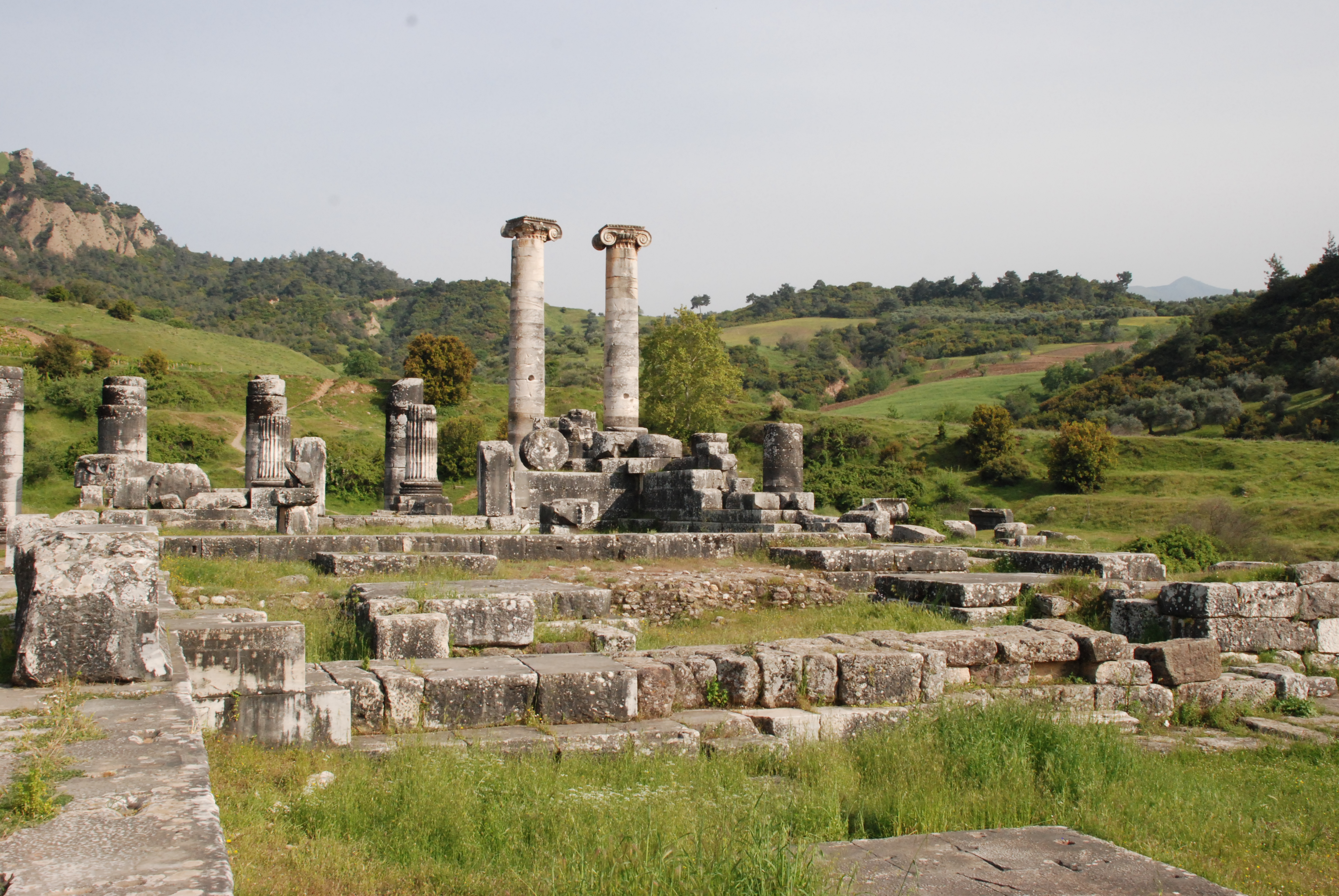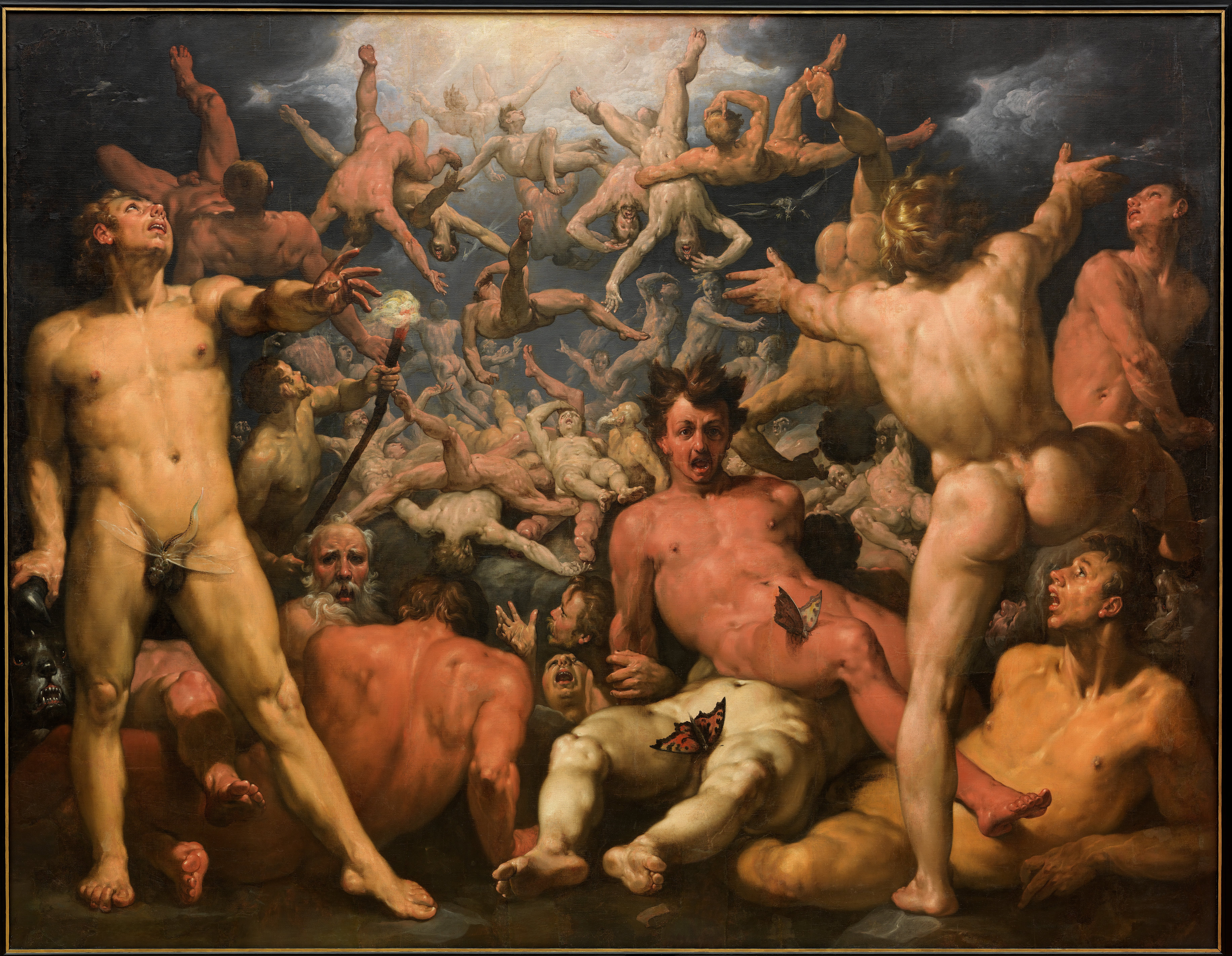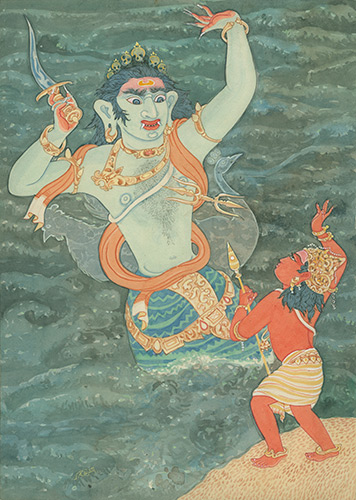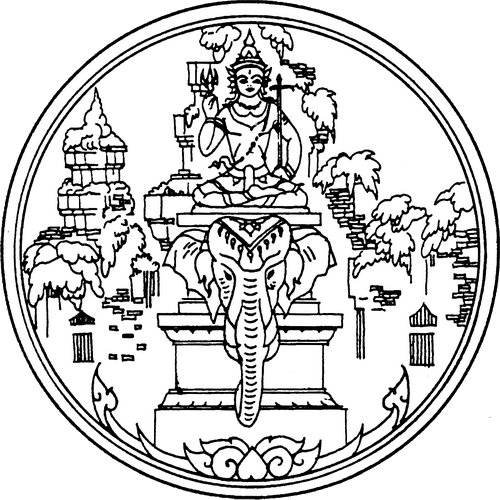|
Šanta
Šanta (Santa) was a god worshiped in Bronze Age Anatolia by Luwians and Hittites. It is presumed that he was regarded as a warlike deity, and that he could additionally be associated with plagues and possibly with the underworld, though the latter proposal is not universally accepted. In known texts he frequently appears alongside Iyarri, a deity of similar character. He is first attested in documents from Kanesh dated to the Old Assyrian period, and continues to appear in later treaties, ritual texts and theophoric names. He is also present in an offering lists from Emar written in Akkadian, though he did not belong to the local pantheon and rituals involving him were only performed on behalf of the Hittite administration by local inhabitants. No references to Šanta are known from the centuries immediately following the fall of the Hittite Empire, but later Neo-Assyrian texts record theophoric names invoking which confirm he continued to be worshiped in the first millennium ... [...More Info...] [...Related Items...] OR: [Wikipedia] [Google] [Baidu] |
Iyaya
Iyaya was a Hittite and Luwian goddess. Her functions remain uncertain, though it has been suggested she was associated with water or more broadly with nature. She might have been associated with the god Šanta, though the available evidence is limited. Her main cult centers were Lapana and Tiura, though she was also worshiped in other cities. Name and character The precise origin of Iyaya's name cannot be established, though it is agreed that it was neither Hattic nor Hurrian in origin. In scholarship she has been described both as a Hittite and Luwian goddess. Not much is known about Iyaya's specific role in the Hittite pantheon. She has been described as a spring goddess, and as a deity responsible for dispensing water. A Hittite text listing the statues of various deities describes her as accompanied by two mountain sheep. The presence of animals might indicate she was a nature deity. Associations with other deities According to , it can be assumed that Iyaya was regard ... [...More Info...] [...Related Items...] OR: [Wikipedia] [Google] [Baidu] |
Iyarri
Iyarri, also known as Yarri, was a god worshiped by Hittites and Luwians in Anatolia in the Bronze Age. He was associated with plague and war, and was portrayed as an archer whose arrows inflicted people with illnesses. While it is generally assumed that Iyarri was male, a female form of this deity is mentioned in a single text. It has been proposed that Iyarri might have developed from the Mesopotamian god Erra, or that he was influenced by him. A different proposal considers his name a cognate of that of Greek Ares, though the evidence in favor of this view is not conclusive. Evidence of the worship of Iyarri in Hittite religion and Luwian religion comes mostly from central Anatolia, and includes documents such as oath formulas, treaties and descriptions of rituals. Temples dedicated to him existed in Ḫarranašši and Guršamašša. He is also attested in a number of theophoric names. References to him postdating the fall of the Hittite Empire are infrequent, and it has been ... [...More Info...] [...Related Items...] OR: [Wikipedia] [Google] [Baidu] |
Lydia
Lydia (; ) was an Iron Age Monarchy, kingdom situated in western Anatolia, in modern-day Turkey. Later, it became an important province of the Achaemenid Empire and then the Roman Empire. Its capital was Sardis. At some point before 800 BC, the Lydian people achieved some sort of political cohesion, and existed as an independent kingdom by the 600s BC. At its greatest extent, during the 7th century BC, it covered all of western Anatolia. In 546 BC, it became a Lydia (satrapy), satrapy of the Achaemenid Empire, known as ''Sparda'' in Old Persian. In 133 BC, it became part of the Roman Republic, Roman Asia (Roman province), province of Asia. Lydian coins, made of electrum, are among the oldest in existence, dated to around the 7th century BC. Geography Lydia is generally located east of ancient Ionia in the modern western Turkish provinces of Uşak Province, Uşak, Manisa Province, Manisa and inland İzmir Province, İzmir.Rhodes, P.J. ''A History of the Classical Greek ... [...More Info...] [...Related Items...] OR: [Wikipedia] [Google] [Baidu] |
Titans
In Greek mythology, the Titans ( ; ) were the pre-Twelve Olympians, Olympian gods. According to the ''Theogony'' of Hesiod, they were the twelve children of the primordial parents Uranus (mythology), Uranus (Sky) and Gaia (Earth). The six male Titans were Oceanus, Coeus, Crius, Hyperion (Titan), Hyperion, Iapetus, and Cronus; the six female Titans—called the Titanides () or Titanesses—were Theia, Rhea (mythology), Rhea, Themis, Mnemosyne, Phoebe (Titaness), Phoebe, and Tethys (mythology), Tethys. After Cronus mated with his older sister Rhea, she bore the first generation of Olympians: the six siblings Zeus, Hades, Poseidon, Hestia, Demeter, and Hera. Certain other descendants of the Titans, such as Prometheus, Atlas (mythology), Atlas, Helios, and Leto, are sometimes also called Titans. The Titans were the former gods: the generation of gods preceding the Twelve Olympians#Olympians, Olympians. They were overthrown as part of the Greek succession myth, which tells how Cron ... [...More Info...] [...Related Items...] OR: [Wikipedia] [Google] [Baidu] |
Sumerogram
A Sumerogram is the use of a Sumerian cuneiform character or group of characters as an ideogram or logogram rather than a syllabogram in the graphic representation of a language other than Sumerian, such as Akkadian, Eblaite, or Hittite. This type of logogram characterized, to a greater or lesser extent, every adaptation of the original Mesopotamian cuneiform system to a language other than Sumerian. The frequency and intensity of their use varied depending on period, style, and genre. In the same way, a written Akkadian word that is used ideographically to represent a language other than Akkadian (such as Hittite) is known as an ''Akkadogram''. In the transliteration of ancient texts Sumerograms are normally represented by majuscule letters. Most signs have a number of possible Sumerian sound values. The scribes and readers of texts using these Sumerograms would not necessarily have been aware of the Sumerian language, with the ''Sumerograms'' functioning as ideograms or lo ... [...More Info...] [...Related Items...] OR: [Wikipedia] [Google] [Baidu] |
Ramayana
The ''Ramayana'' (; ), also known as ''Valmiki Ramayana'', as traditionally attributed to Valmiki, is a smriti text (also described as a Sanskrit literature, Sanskrit Indian epic poetry, epic) from ancient India, one of the two important epics of Hinduism known as the ''Itihasas'', the other being the ''Mahabharata''. The epic narrates the life of Rama, the seventh ''avatar'' of the Hindu deity Vishnu, who is a prince of Ayodhya (Ramayana), Ayodhya in the kingdom of Kosala. The epic follows Exile of Lord Rama, his fourteen-year exile to the forest urged by his father King Dasharatha, on the request of Rama's stepmother Kaikeyi; his travels across the forests in the Indian subcontinent with his wife Sita and brother Lakshmana; the kidnapping of Sita by Ravana, the king of Lanka, that resulted in bloodbath; and Rama's eventual return to Ayodhya (Ramayana), Ayodhya along with Sita to be crowned as a king amidst jubilation and celebration. Scholarly estimates for the earliest stage ... [...More Info...] [...Related Items...] OR: [Wikipedia] [Google] [Baidu] |
Mahabharata
The ''Mahābhārata'' ( ; , , ) is one of the two major Sanskrit Indian epic poetry, epics of ancient India revered as Smriti texts in Hinduism, the other being the ''Ramayana, Rāmāyaṇa''. It narrates the events and aftermath of the Kurukshetra War, a war of succession between two groups of princely cousins, the Kauravas and the Pandava, Pāṇḍavas. It also contains Hindu philosophy, philosophical and devotional material, such as a discussion of the four "goals of life" or ''puruṣārtha'' (12.161). Among the principal works and stories in the ''Mahābhārata'' are the ''Bhagavad Gita'', the story of Damayanti, the story of Shakuntala, the story of Pururava and Urvashi, the story of Savitri and Satyavan, the story of Kacha (sage), Kacha and Devayani, the story of Rishyasringa and an Ramopakhyana, abbreviated version of the ''Rāmāyaṇa'', often considered as works in their own right. Traditionally, the authorship of the ''Mahābhārata'' is attributed to Vyasa, Vy ... [...More Info...] [...Related Items...] OR: [Wikipedia] [Google] [Baidu] |
Kartikeya
Kartikeya (/Sanskrit phonology, k…ë…ætÙ…™kej…ô/; ), also known as Skanda (Sanskrit phonology, /sk…ônÙdÙ…ô/), Subrahmanya (/Sanskrit phonology, s äb…æ…ô…¶m…ô…≤j…ô/, /…ï ä-/), Shanmukha (Sanskrit phonology, /…ï…ënm äk ∞…ô/) and Murugan (/Sanskrit phonology, m ä…æ äg…ôn/), is the Hinduism, Hindu List of war deities, god of war. He is generally described as the son of the deities Shiva and Parvati and the brother of Ganesha. Kartikeya has been an important deity in the Indian subcontinent since Vedic period, ancient times. Mentions of Skanda in the Sanskrit literature data back to fifth century BCE and the mythology relating to Kartikeya became widespread in North India around the second century BCE. Archaeological evidence from the first century CE and earlier shows an association of his iconography with Agni, the Hindu god of fire, indicating that Kartikeya was a significant deity in early Hinduism. He is hailed as the "favoured god of the Tamils", and the tutelary dei ... [...More Info...] [...Related Items...] OR: [Wikipedia] [Google] [Baidu] |
Hindu God
Hindu deities are the gods and goddesses in Hinduism. Deities in Hinduism are as diverse as its traditions, and a Hindu can choose to be polytheistic, pantheistic, monotheistic, monistic, even agnostic, atheistic, or humanist. Julius J. Lipner (2009), Hindus: Their Religious Beliefs and Practices, 2nd edition, Routledge, , p. 8; Quote: "(...) one need not be religious in the minimal sense described to be accepted as a Hindu by Hindus, or describe oneself perfectly validly as Hindu. One may be polytheistic or monotheistic, monistic or pantheistic, even an agnostic, humanist or atheist, and still be considered a Hindu." The terms and epithets for deities within the diverse traditions of Hinduism vary, and include Deva, Devi, Ishvara, Ishvari, Bhagavān and Bhagavati. The deities of Hinduism have evolved from the Vedic era (2nd millennium BCE) through the medieval era (1st millennium CE), regionally within Nepal, Pakistan, India and in Southeast Asia, and across Hinduism ... [...More Info...] [...Related Items...] OR: [Wikipedia] [Google] [Baidu] |
Indo-European Languages
The Indo-European languages are a language family native to the northern Indian subcontinent, most of Europe, and the Iranian plateau with additional native branches found in regions such as Sri Lanka, the Maldives, parts of Central Asia (e.g., Tajikistan and Afghanistan), Armenia, and areas of southern India. Historically, Indo-European languages were also spoken in Anatolia. Some European languages of this family—English language, English, French language, French, Portuguese language, Portuguese, Russian language, Russian, Spanish language, Spanish, and Dutch language, Dutch—have expanded through colonialism in the modern period and are now spoken across several continents. The Indo-European family is divided into several branches or sub-families, including Albanian language, Albanian, Armenian language, Armenian, Balto-Slavic, Celtic languages, Celtic, Germanic languages, Germanic, Hellenic languages, Hellenic, Indo-Iranian languages, Indo-Iranian, and Italic languages, ... [...More Info...] [...Related Items...] OR: [Wikipedia] [Google] [Baidu] |
Phonetic Transcription
Phonetic transcription (also known as Phonetic script or Phonetic notation) is the visual representation of speech sounds (or ''phonetics'') by means of symbols. The most common type of phonetic transcription uses a phonetic alphabet, such as the International Phonetic Alphabet. Versus orthography The pronunciation of words in all languages changes over time. However, their written forms (orthography) are often not modified to take account of such changes, and do not accurately represent the pronunciation. Words borrowed from other languages may retain the spelling from the original language, which may have a different system of correspondences between written symbols and speech sounds. Pronunciation can also vary greatly among dialects of a language. Standard orthography in some languages, such as English language, English and Classical Tibetan, Tibetan, is often irregular and makes it difficult to predict pronunciation from spelling. For example, the words ''bough'', ''tough' ... [...More Info...] [...Related Items...] OR: [Wikipedia] [Google] [Baidu] |
Diacritic
A diacritic (also diacritical mark, diacritical point, diacritical sign, or accent) is a glyph added to a letter or to a basic glyph. The term derives from the Ancient Greek (, "distinguishing"), from (, "to distinguish"). The word ''diacritic'' is a noun, though it is sometimes used in an attributive sense, whereas ''diacritical'' is only an adjective. Some diacritics, such as the acute , grave , and circumflex (all shown above an 'o'), are often called ''accents''. Diacritics may appear above or below a letter or in some other position such as within the letter or between two letters. The main use of diacritics in Latin script is to change the sound-values of the letters to which they are added. Historically, English has used the diaeresis diacritic to indicate the correct pronunciation of ambiguous words, such as "coöperate", without which the letter sequence could be misinterpreted to be pronounced . Other examples are the acute and grave accents, which can indica ... [...More Info...] [...Related Items...] OR: [Wikipedia] [Google] [Baidu] |







